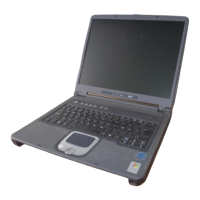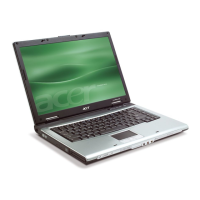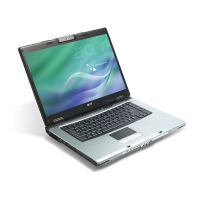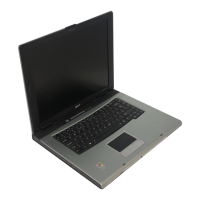What to do if POST detects an error on Acer TRAVELMATE 2440 3640?
- DDr. Tyler OrtizJul 29, 2025
If the POST detects an error and displays messages on the screen of your Acer Laptop, consult the error message list for troubleshooting steps.

What to do if POST detects an error on Acer TRAVELMATE 2440 3640?
If the POST detects an error and displays messages on the screen of your Acer Laptop, consult the error message list for troubleshooting steps.
What to do if Acer Laptop has intermittent problems?
If you are experiencing intermittent problems with your Acer Laptop, use the customer-reported symptoms and consult the information on error messages, intermittent problems and undetermined problems.
| Processor | Intel Pentium M or Intel Celeron M |
|---|---|
| RAM | Up to 2GB DDR2 |
| Resolution | 1024 x 768 |
| Graphics | Intel Graphics Media Accelerator 900 |
| Storage | 40GB, 60GB, 80GB, or 100GB HDD |
| Optical Drive | DVD/CD-RW combo |
| Networking | 10/100 Mbps Ethernet |
| Wireless | 802.11b/g |
| Ports | 3x USB 2.0, VGA, Ethernet, headphone, microphone |
| Battery | 6-cell Li-ion |
| Operating System | Windows XP Professional or Home |
Summary of the computer's many features.
Graphic representation of the computer's internal components and connections.
Diagrams showing the physical layout of components on the main board.
Explores the physical features and components of the notebook.
Explains the keyboard layout, keys, and special functions.
Utilities for managing system functions and optimizing performance.
Guide to using built-in system management tools.
Detailed technical specifications of the computer's hardware components.
Utility for configuring system hardware settings and boot options.
Instructions on how to navigate and use the BIOS setup interface.
Displays system hardware information and BIOS details.
Shows system hardware summary and basic setup parameters.
Configuration options for system passwords and security features.
Settings for controlling the order of boot devices.
Options for saving or discarding BIOS setup changes.
Procedure for updating the system's BIOS firmware.
Important precautions and tools needed before disassembling the computer.
Visual guide detailing the sequence for component disassembly.
Step-by-step instructions for safely removing the battery.
Guide for removing memory, HDD, wireless LAN, ODD, and LCD modules.
Instructions for separating the main unit into upper and lower case assemblies.
Steps to take apart the upper case assembly.
Detailed steps for disassembling the LCD module and its camera.
Procedures for removing external components like HDD and ODD.
Diagnostic tests for checking external drives, keyboard, and memory.
Steps to verify the computer's power sources (adapter and battery).
Explains POST error messages and their likely causes.
A list of error codes and their corresponding messages.
Interpretation of beep codes generated during the POST process.
Maps symptoms to specific FRU (Field Replaceable Unit) actions.
Procedures for isolating issues when diagnostic tools fail to identify the cause.
Identifies jumpers and connectors on the top side of the main board.
Identifies jumpers and connectors on the bottom side of the main board.
Instructions for clearing the BIOS password using jumpers.
List of main board assemblies and their part numbers.
List of compatible RAM modules (DIMMs) and their specifications.
List of compatible AC adapters for the notebook.
List of available battery pack options and their specifications.
List of compatible main boards and expansion cards.
Part numbers for various internal and external cables.
List of chassis parts, covers, and brackets.
List of compatible CPU models for the notebook.











